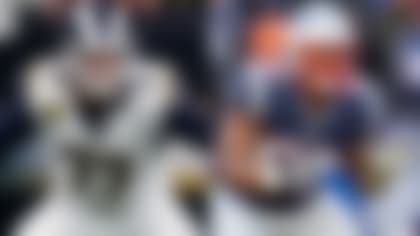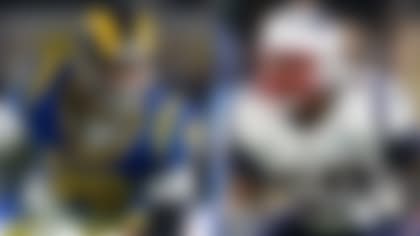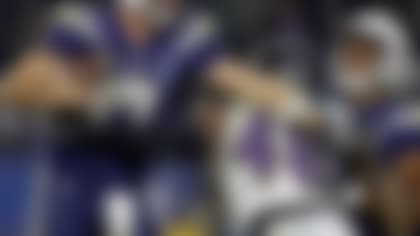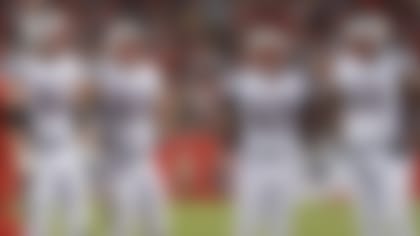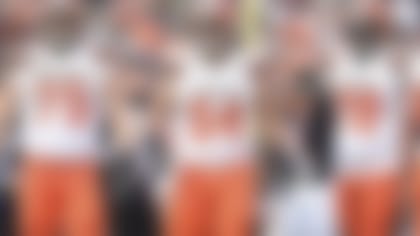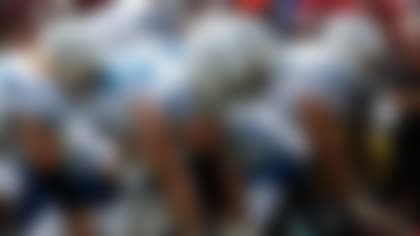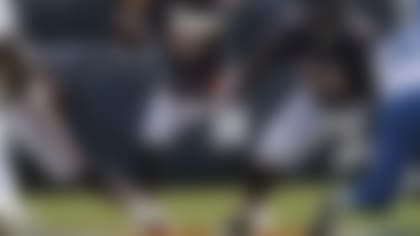Football is again on its annual grand stage.
Millions around the world will watch the New England Patriots take on the Philadelphia Eagles, and watch multi-million-dollar commercials in between the action. Long runs, touchdown passes and acrobatic plays await.
Also included are the warriors of the trenches, the big uglies who battle to establish supreme leverage and position. In the game of inches, these increments are often the most important and influential in determining a winner. But rare are the offensive lines -- and those who play it -- considered sexy enough for spotlight attention during the lead up to the sport's biggest contest.
Not here.
As we've done all season, we not only appreciate but understand and explain what goes on with these large fellas. It's time again to go Behind The Offensive Line (PRESENTED BY FORD) for a Super Sunday edition. Let's explore how one offensive line's group matchup could determine what retailers love to call the Big Game.
New England's resistance
It's not difficult to find a coach or player describing how to beat Brady: You have to pressure him up in the middle and collapse the edges.
Von Miller talked about it in his Players' Tribune piece on Friday. Jacksonville had the personnel to do it but didn't follow through. It ended up burning them.
New England's offensive line isn't filled with the stalwarts of old -- Logan Mankins, Matt Light, Dan Koppen -- and allowed the most QB hits in the entire league in 2017, but as a group, did a solid job of giving Brady time to work on Conference Championship Weekend. It also surprisingly boasts some high-ranking linemen, per Pro Football Focus.
Left tackle Nate Solder doesn't lead this group. In fact, he's the lowest-rated member of the starting five, according to PFF's grading. Center David Andrews ranks sixth, right guard Shaq Mason ranks ninth, left tackle Joe Thuney is 13th, right tackle Cameron Fleming is 25th and Solder is 32nd.
So, in going back to that AFC title game between Jacksonville and New England, the grades shed some light on why the game unfolded how it did. The Jaguars owned a presumed interior advantage, in tackles Malik Jackson and Marcell Dareus. Early on -- especially when a rusher de-cleated Mason -- it looked like that would play in the favor of Jacksonville, who was pressuring New England up the middle early. All was going according to plan.
But New England adjusted, thanks to Mason, Andrews and Thuney. The middle rush became ineffective (especially for a defense that was on the field far too long in the second half), Brady had time to survey behind his trusty interior and we all know how that played out.
How does this group match up against an even better front four? Well...
There's good and bad news. Let's get the painful part over with first.
We know what the Patriots will get from their running backs, who excel in the running and passing games. Though Mason and Andrews are grading the best, New England is averaging a slightly better yards-per-carry average (4.56 yards) running off the left tackle (Solder), per Next Gen Stats. This is also boosted by a higher number of carries in that direction (152) as opposed to the right side (97). Combined, edge rushes are more productive for New England (249 carries for 1,111 yards) than runs inside the tackles (191 carries for 811 yards). When considering New England's personnel, which lacks a true inside-the-tackles hammer (Mike Gillislee is serviceable, but that true hammer is now playing for Philadelphia), this makes sense.
But as the edge gives, the edge also takes. We'll key on one crucial matchup: Solder vs. Philadelphia's Vinny Curry, who lines up on over the left tackle on 95.6 percent of plays.
Solder ranks 44th in the NFL among offensive tackles in pass blocking efficiency, allowing 51 pressures on the year. He's surrounded by tackles like Marshall Newhouse (the weakest part of Oakland's offensive line), and Carolina's Matt Kalil, but is also near effective tackles like Garrett Bolles, Pro Bowler Alejandro Villanueva, Cam Robinson and Super Bowl opponent Halapoulivaati Vaitai, who's done an admirable job in place of the injured Jason Peters. Kind of a confusing group, no?
Ranking by that total pressures metric plunges him to a tie for 49th, though, and his company -- Dallas' La'el Collins, Seattle's Germain Ifedi, Arizona's John Wetzel and Cleveland's Shon Coleman -- starts to reveal the caliber of his play. What's worse, he's facing an effective and relentless rusher in Curry, who's tied for 20th in pass rushing efficiency with the likes of Cameron Jordan, and one-tenth of a point behind Carlos Dunlap, two havoc-wreakers in this league. Solder is looking at a long day against a guy who's registered 47 total pressures, with 45 coming from Solder's side.
Time for the good news: Solder did well against a tough matchup in Jacksonville's variety of athletic edge rushers, earning an 82 grade from PFF. New England has a good counter in the interior, too. Andrews came out of that game with a 69.8 grade, which Thuney broke 74. In fact, Mason had the worst game, which didn't end up being all that damaging.
They'll need all three of their interior linemen to play well against Fletcher Cox, one of the most imposing, powerful and explosive interior linemen in the league (No. 2 in the NFL, per PFF). They're also facing the league's best defense in total pressures per game (16.9).
The kicker is what Miller mentioned is a must for a playoff win over New England: A defense must pressure Brady consistently with just a four-man rush. Philadelphia has the second-highest pressure rate with a four-man rush (38.1 percent) and has seven players with 20-plus pressures, led by Cox.
Expect more 21 personnel (two running backs, one tight end) to help in protection against this defense. Offensive lines own a numbers advantage against a four-man rush, and Brady isn't slow with his decision making, but he can get rattled by constant pressure and contact. A chip from a tight end or running back can go a long way toward keeping the contact to a minimum, and force Philadelphia to blitz. In the latter scenario, Brady thrives in what again becomes a simple numbers game. More blitzers, less in coverage.
But as described above, Philadelphia has the personnel -- we didn't even mention the play of Brandon Graham (No. 9 defensive end), who will match up against Fleming, and veteran reserve Chris Long (No. 28) -- to get to Brady without much of a blitz.
The chess match of rush numbers versus protection numbers will ensue as the game unfolds. Whoever gains an early advantage will likely also grab the early lead. Instead of following the ball to the skilled-position stars early in Super Bowl LII, watch the trenches. They'll tell you a lot about how the game will play out.

